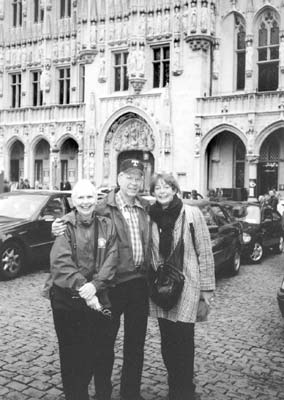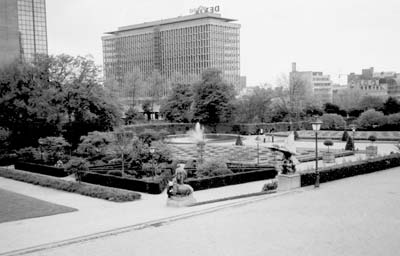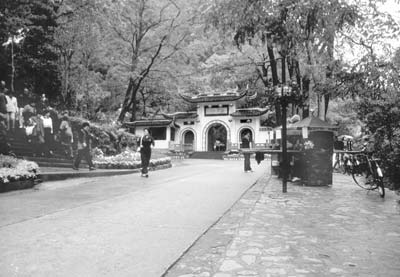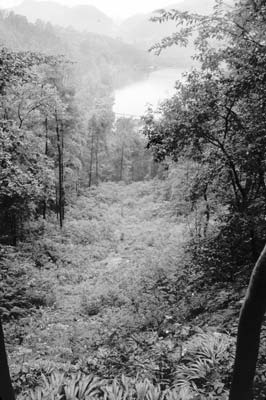An Oasis in the City
Have you ever been in a big, busy city overseas, dodging traffic, recoiling from the noise and gasping for air, when suddenly you came upon an oasis of calm and beauty in the form of a garden or park — a refuge of (relative) quiet and nature where people could escape the commotion of downtown? ITN asked its readers to write in about just these sorts of “urban oases” (outside of North America). For each, we asked that readers give an idea of its location in the city, tell how they found it and when they were there and add any other details they wished. The responses are printed below.
If you know of one to add, write to Oasis in the City, c/o ITN, 2116 28th St., Sacramento, CA 95818, or e-mail editor@intltravelnews.com (please include your surface-mail address).
It was my last day in paris, and after a 3½-week whirlwind tour of Europe in September 1999, there I was with the worst cold I’ve ever had! Not wanting to miss one moment, I forced myself out into the busy streets.
Finding myself in the Latin Quarter, I wandered aimlessly, dodging crowds of people. With a last spurt of my dwindling energy, I wandered into the Luxembourg Gardens. My oasis!
Sinking gratefully into a chair beside a fountain-fed pond, I suddenly noticed how quiet it was. No people, no cars, no noise. Instead, fountains, statues, flowers and the energy-restoring sun!
It was all I needed at that very moment, my last day in Paris.
— Michelle Halvorsen
Everett, WA
Probably the least known oasis in paris is the lovely walkway on the Viaduc des Arts. This is the elevated railway that used to run between the Bastille and Bois de Vincennes along avenue Daumesnil in the 12th arrondissement.
A few years ago, the French Government turned about a mile of it into a wonderful green, tree-shaded walkway, high above the noisy avenues and streets. There are benches, bamboo jungles, rose gardens and views — all at no charge. When I was there with an American friend in May ’03, there were exactly four people visiting the half-mile-or-so stretch that we walked.
It is an oasis of calm and beauty, and it is easy to reach. Get off the Métro at Gare de Lyon and walk along Diderot. In two or three blocks you will see the Viaduc ahead of you. There is a nice café on the corner (which used to be Le Pere Tranquil but has changed hands and names recently); no reservations are needed for a salad or sandwich lunch.
An additional bonus to this oasis are the shops in the arches of the viaduct. The French Government has sponsored craft and artisan shops for almost the length of the walkway. There is a wonderful shop for copper and another with hand-painted china, another sells toys, one specializes in fancy lamps and another has hardware.
It makes a nice excursion. Take a walk by going up the stairs at Diderot (you can try the elevator two blocks to the left, but it was not working on several occasions). After that pleasant break in the day’s routine, eat lunch and visit the shops (which generally are closed Sundays and Mondays).
This little-known park and walkway, elevated above the city din, is a real treaure, a little gem as yet not found by most people, whether tourists or residents.
— Dr. Abbie Salny
Wayne, NJ
When in the midst of dublin’s bustle, I always find a quiet moment of respite in St. Stephen’s Green. Located at the top of the pedestrianized Grafton Street walking mall, it is a haven of peace.
My first time in the park (and I have visited it more than 15 times since 1990), I was amazed as I left the clatter of Dublin’s busy streets for a green haven of ducks, flowers and sculpture. I walked under Fusilier’s Arch (also known as the Traitors’ Arch), through a tunnel of thick bushes and into a bright and colorful clearing with a fountain and flower beds. It was magical.
Tired of the gray pavement, gray skies and gray air, I had needed a break and a breather, and I found it in St. Stephen’s Green. I also found Dubliners on their lunch breaks, kids on bikes and dogs running freely. Now, whenever I visit Dublin, I sit in the park with a sandwich for a peaceful lunch, then stroll the outer edges of the park, admiring the statues in tribute to Wolfe Tone (also known as “Tone Henge”) and James Joyce.
Once a pasture for the city’s livestock, St. Stephen’s Green was eventually purchased by Arthur Guinness — the famed brewer of beer — and given to the people of Dublin as a sanctuary. Pop in to see for yourself and enjoy Guinness’ gift of an oasis in the city of Dublin.
— Jennifer Eisenlau
Boulder, CO
In response to ITN’s challenge, I can think of a number of hidden refuges in noisy cities (like Kyoto with its many lovely gardens), but perhaps the greatest contrast I have found is one in vibrant rio de janeiro, where a reasonably priced taxi ride took me to the exotic Tijuca Forest above the city, where a still pond or a lovely old fountain will delight.
For the pièce de résistance, however, you must stop at the “Chinese Lookout” with its breathtaking view onto Rio in probably the most magnificent setting on the planet. I have taken that ride on a number of occasions throughout the years and have never tired of it. What’s more, I have never encountered more than a very few souls there.
— Joseph Kissoczy
Sunnyvale, CA
In making our choices for an Oasis in the City, we remembered two distinct places.
• The first was a park in buenos aires, Argentina. During a trip in November 1995, we had been walking most of the day, taking in all the sights and sounds of this fascinating Latin city. As we neared our hotel, we came upon a large park. We were tired, and the temptation to sit and relax in the shade was more than we could resist.
The park was Plaza San Martin and it filled several city blocks. There were the usual accoutrements — flowers, benches, fountains, statues — however, in the middle was the focal point of the entire park: an enormous gomero tree.
This old beauty must have been at least 300 years old. It provided shade and comfort to those walking by, but more important was its one unique feature: the roots were huge, and since they were mostly aboveground they formed private niches where people could relax, talk, share food and generally enjoy a quiet respite from the busy city streets.
The scene was calming, and we found ourselves relaxing in its shade like all the others — a charming end to our day in Buenos Aires.
• Secondly, while in singapore in February ’03 we happened upon the Singapore Botanical Gardens. Our hotel was located about a mile from one of its entrances. While exploring the interests of the area, the humidity and heat became too much to endure and we turned into the gardens.
Here we shared a Sunday afternoon with the local citizens. It was a scene of serenity that one might find anywhere in the world — blankets spread on the grass; children running and playing, and swans being fed at the small lake. Just to be able to observe was truly a treasure. The heat and humidity seemed to leave us as we relaxed and became a part of the local population.
After an hour or so, we were able to continue our exploration, truly refreshed by the gardens and its inhabitants.
— Barbara G. Hubinger
Danville, CA
It was our pleasure to come upon an oasis in the center of the city of brussels, Belgium, while we were on the “Great Rivers of Europe” cruise-tour with Grand Circle Travel during the first three weeks of May ’02.
After having explored the Grand’Place (Grote Markt) along with its old Town Hall and many of the guild houses, we decided to walk back to our hotel along with four other tour travelers. As we walked the approximately 15 city blocks to our hotel (the Mercure), we were dodging traffic, recoiling from the noise and gasping for air when we came upon an oasis of calm and beauty in the form of a large beautiful park named Jardin Boutanique Kruidtuin in central Brussels.
The botanical gardens were beautiful and meticulously manicured by the groundskeepers. This park was located on the corner of Rue Royale/Koningstraat and Boulevard du Jardin Boutanique Kruidtuin. As seen in the picture, all the tall buildings around the gardens give evidence that this was in the central part of the city.
— Harold G. Prochnow
Sequin, TX
Re an Oasis in the City, my favorite spot is the park/gardens surrounding Schloss Nymphenburg in munich, Germany. Visiting in late May ’03, I enjoyed a quiet time sitting on a bench in the shade with a book and picnic lunch. It was only a few minutes from the Marienplatz via tram and was particularly welcome, since I was still in the “decompression” stage of my vacation.
— Fran Treisbach
Harrisburg, PA
I nominate as my Oasis in the City the park called Savignyplatz in berlin, Germany. It’s only one subway stop away from the city center and the central train station, Bahnhof Zoo.
This little park, with its plots of English-type gardens surrounding benches tucked into semisecluded natural alcoves, is a pleasure to behold, especially during spring and summer.
The city does a wonderful job in maintaining the park, and the public does not drop a wrapper or any trash except into designated trash cans. I can sit there and recoup in minutes.
— Peter & Eleanor Jarovitzky
Boynton Beach, FL
I’d spent a drizzly night in guiyang, the capital of southwest China’s Guizhou Province, only because my flight from Kunming had arrived after dark. After a leisurely breakfast of sweetened hot milk and steamed buns, I arrived at the bus station at 9 a.m. on Monday, thankful to be getting out of what seemed like a troglodyte city squeezed between mountainous karst formations and buried under elevated highways with apartment blocks and 3.5 million people. Unfortunately, the next bus wasn’t leaving until 4. (This was in 2000, the year before half-hourly van service was introduced.)
A bus conductor appeared and indicated that I should follow her. Weaving among buses, she finally stopped at a shiny, new, purple, Guilin Daewoo Bus Company sleeper bus. I peered inside at spotless bunk beds, two upper and two lower, each with a new mattress, sheet, down comforter and pillow. Though leery of spending six hours in a sleeper bus, at least I could leave my bag there and return anytime.
I stowed my bag and, pointing to Qianling Park on my map, inquired of the conductor which direction to go. It was only a few blocks away, but I kept asking directions because I couldn’t believe a park with a forest, mountain, monastery and lake was truly downtown. It was. The entrance fee was five yuan (60¢).
A rather wide stream ran between two walkways, ending at a pool with the obligatory moon bridge. Hundreds of pots of flaming salvia and golden mums lined the walkways. Forested hills rose on either side. Almost immediately I entered a surreal world that seemed to move in another time frame. Couples and groups in leisure gear strolled slowly along the path. And, at 9:30 in the morning, there was music everywhere.
Shrill songs came from caged birds placed high in the trees serenading less fortunate pals whose cages rested near the path.
Blocking the walkway was a group of line-dancing ladies. Their no-nonsense teacher often stopped the boom-box country music and corrected their steps.
Lured by strange music, I climbed up a hill to find a mixed-bag orchestra. Ancient stringed instruments mingled melodiously with saxophones and clarinets.
Back on the walkway, I was drawn across the stream, just behind the Challenger Space Simulator (which simulates flight for the occupants), where high-pitched voices from a group of older adults were accompanied by an accordionist. Two women nearby rhythmically wound their knitting yarn into a ball.
A clatter caused by Chinese cymbals falling from a kiosk sign drew a laughing crowd that only encouraged the juvenile monkey who had done the damage. The kiosk owner jabbed at him with a bamboo pole while a monkey friend performed gymnastics on an electrical high-wire.
As I continued up the hill, the people kept coming and I realized I’d missed a massive tai chi session. By the time I reached the turn leading up 383 steps to Hong Fu Temple, hundreds of people had streamed by.
The plaintive sounds of a flute lured me to a bench near the young flautist. I finally realized the music came not from a flute but from a leaf. It didn’t seem startling then, in this strange land, that just beyond the leaf-musician a dromedary camel awaited a photo op.
As I climbed higher, I kept hearing howls and thought they were from monkeys until a man stopped in front of me, bent his knees, extended his arms, let out a ferocious howl, then calmly resumed his stroll. At about the same time, I glimpsed the lake far below where a young woman who was facing the lake and furiously flexing her pelvic muscles let out a heart-wrenching scream. Next a woman passed me going uphill. . . backward.
At the temple I watched a 3-year-old girl eagerly follow instructions for her first kowtow to Buddha. Outside, I skipped the rest room guarded by 50 monkeys.
Chinese classical music wafting over the lake from a vermilion pavilion was the quintessential postcard setting for lunch until I was jolted from my reverie as the music changed, in my honor, to “Hey, Jude.”
Dreading the arduous climb back, I noticed a group boarding a dilapidated electric train. I bought a ticket and zipped through the mountain’s dark tunnel, emerging at the park entrance just as elderly men with long bamboo poles were retrieving their birdcages. It was a perfect round trip through an age that seemed particularly golden.
— Dorothy Aksamit
Sausalito, CA
If the traffic hurts your ears in downtown athens, just go a few yards into the National Gardens, near Syntagma Square, and you’ll escape to a quiet, green refuge. I returned there three times in three days on my visit in spring 1999. It’s close to Hotel Grande Bretagne.
— Joan L. Welch
Pinellas Park, FL
For an Oasis in the City, I have two selections for rome, where a “place of repose” is always welcome.
• My favorite is Parco Questura, a rectangle of repose on the southern brow of Quirinal Hill between Via del Quirinale on the north of the park, across from the walled gardens of the Palazzo Quirinale (residence of the president of the Republic of Italy and a papal palace before 1870), and Via Piacenza on the south (lower) side of the park.
This is a beautifully landscaped, palm-crowned park that is not only often empty but conveniently situated between Stazione Centrale Roma and busy Piazza Barbarini. If that were not enough, the park is found between two of the most exquisite churches in Rome: Francisco Borromini’s superbly proportioned masterpiece San Carlo alle Quattro Fontane (built 1638-1641), on the east side of the park, and G.L. Bernini’s splendidly baroque and gloriously ornamented San Andrea al Quirinale (1658-1670) on the west side of the park.
• My second favorite is the Piazza San Gregorio Magno on the southwest corner of the Caelian Hill, fronting the Church of San Gregorio Magno. The No. 13 and No. 3 streamlined trams are adjacent, providing soothing transport back downtown around the Colosseum and north into Rome’s busy center.
I found both of these parks by wandering on foot on my own in Rome, and I have visited them often over the past 15 years. Relax, you’re in Rome!
— Jack Ellenberger
New York, NY
Although its distinctive red domes give the Church of San Giovanni degli Eremiti (St. John of the Hermits) the appearance of an Islamic mosque, it is in fact a Christian church standing as an oasis in the middle of the bustling city of palermo in Sicily. The church, built in the 12th century by King Roger II, is undoubtedly the work of Moorish artists.
My wife and I had seen photographs of the five exotic-looking red domes of the church in a number of different guidebooks. The guidebooks invariably commented on the beauty of the subtropical garden within the unique architectural gem.
We knew that the church was not far from the central Palermo neighborhood in which our hotel was located, since we had already glimpsed in the distance one or two of its red domes while exploring the sights of the city. And because we are both lovers of quiet city park spaces (on this June ’03 trip we had already explored the beautiful Giardino Garibaldi with its magnificent, centuries-old banyan trees), we decided to devote an hour or so to exploring San Giovanni degli Eremiti.
Our first surprise occurred when we attempted to locate the church. Because the modern city of Palermo is a complicated series of neighborhood streets and alleyways superimposed on a medieval grid, often the shortest route between two points is not a straight line. We would walk toward the red-domed structure only to find 10 minutes later that it was now behind us and that we were walking away from it.
We would walk down long, winding hills only to look up and see the church above us. Of course, after climbing back up the hill we would see that the church had magically materialized down below.
We finally happened upon a tiny church at the bottom of a busy thoroughfare and showed the picture of the church in a guidebook to a man we assumed was a local Palermitano. I pointed to the picture and asked in my best tourist Italian, “Dove?” (“Where?”), to which he answered, “Qui” (“Here”).
Apparently, although the red domes could be seen from afar, they were not visible when standing in front of the church itself, that is, not until we walked inside the gate. From the interior courtyard, the magnificent red domes of the church lent their ethereal presence to everything within. And just as the guidebooks had promised, we found ourselves in a “haven of peace where even the noise of Palermo traffic (was) muffled.”
We were standing in what felt like a garden of an ancient Roman villa filled with palm trees plus orange, Chinese mandarin and pomegranate trees, bougainvilleas, roses and jasmine.
Best of all, the garden, surrounded by the walls of the church, itself surrounds the ruins of a small medieval cloister with decaying twin columns and pointed arches.
Not since the afternoon spent in the magical grotto of the legendary burial site of King Arthur near Glastonbury, England, had we experienced the calm and tranquil state of mind that comes from finding peace in the gentle juxtaposition of the human-constructed and nature-made environment.
— Barry A. Bass
Baltimore, MD





